At the Administrative Appeals Tribunal (AAT), we give individuals and organisations the opportunity to have administrative decisions independently reviewed. We review decisions made by Australian Government ministers, departments and agencies and, in limited circumstances, decisions made by state and territory government and some non-government bodies.
The types of decisions the AAT most commonly reviews relate to:
- Australian citizenship
- child support
- family assistance and social security
- migration and refugee visas
- the National Disability Insurance Scheme
- taxation
- veterans’ entitlements
- workers’ compensation under Commonwealth laws.
We also review a wide range of other decisions, including decisions about aged care, bankruptcy, child care services, civil aviation, corporations and financial services regulation, customs, education regulation, freedom of information, paid parental leave, passports, professional regulation, security assessments by the Australian Security Intelligence Organisation and unpaid employment entitlements.
We can only review a decision if a law states that the decision can be reviewed by the AAT. We review decisions ‘on the merits’: we take a fresh look at the facts, law and any government policy relating to the decision and arrive at our own decision. We consider all the material before us, including any new information given to us during the review, and decide what is the correct or preferable decision in each case. We aim to make our review processes accessible, fair, just, economical, informal, quick and proportionate.
We manage our workload in 9 divisions:
- Freedom of Information (FOI) Division
- General Division
- Migration and Refugee Division
- National Disability Insurance Scheme (NDIS) Division
- Security Division
- Small Business Taxation Division
- Social Services and Child Support Division
- Taxation and Commercial Division
- Veterans’ Appeals Division.
The AAT is led by President Justice David Thomas, a judge of the Federal Court of Australia and also consists of other members appointed as Deputy Presidents, Senior Members and Members. The President is responsible for the overall management of the AAT with the assistance of the Deputy Presidents appointed as Division Heads and the Registrar, Sian Leathem.
We also host the Immigration Assessment Authority (IAA), a separate office within the Migration and Refugee Division, which provides a fast track review process in relation to certain decisions to refuse protection (refugee) visas.
Key caseload statistics
The AAT received 54,378 applications in 2019–20, 10% fewer than the number lodged in 2018–19. We finalised 51,605 applications, 16% more than in 2018–19. The number of applications on hand at 30 June 2020 was 72,360, 4% higher than the previous year.
AAT caseload overview, 2015–16 to 2019–20
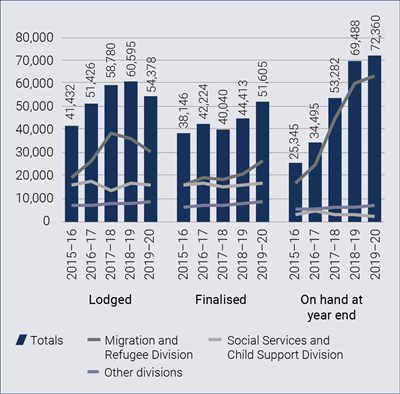
The size of our caseload varies significantly between divisions. The Migration and Refugee Division still received the largest number, despite a drop in lodgements in the latter part of the year as a result of the coronavirus pandemic. Consistent with previous years, the Social Services and Child Support Division had the next highest volume of lodgements. The NDIS Division constituted a small but steadily increasing proportion of the overall caseload with a further increase in lodgements in 2019–20.
Applications lodged, finalised and on hand, 2019–20 – By division
|
DIVISION
|
LODGED
|
FINALISED
|
ON HAND AT YEAR END
|
| No |
% of total |
No |
% of total |
No |
% of total |
| Freedom of Information |
55 |
<1% |
62 |
<1% |
62 |
<1% |
| General |
5,584 |
10% |
5,594 |
11% |
3,956 |
5% |
| Migration and Refugee |
29,976 |
55% |
26,402 |
51% |
63,305 |
87% |
| National Disability Insurance Scheme |
1,780 |
3% |
1,527 |
3% |
922 |
1% |
| Security |
5 |
<1% |
5 |
<1% |
8 |
<1% |
| Small Business Taxation |
274 |
<1% |
75 |
<1% |
318 |
<1% |
| Social Services and Child Support |
15,713 |
29% |
16,749 |
32% |
2,239 |
3% |
| Taxation and Commercial |
797 |
1% |
904 |
2% |
1,320 |
2% |
| Veterans’ Appeals |
194 |
<1% |
287 |
<1% |
230 |
<1% |
| TOTAL |
54,378 |
100% |
51,605 |
100% |
72,360 |
100% |
Our review processes vary according to the type of decision being reviewed, reflecting differences in legislative requirements as well as specific approaches we have developed to deal with the broad range of decisions we review. We give an applicant and any other party to a review a reasonable opportunity to present their case, including the opportunity to give us new information that was unavailable to the original decision-maker. We invite or direct a party to give us information relevant to the case at different stages of the review process.
In some types of cases, we hold conferences or directions hearings to talk to the parties about the issues and the further evidence that may be gathered, and give directions about what the parties must do, and by when, to progress the case. In cases involving more than one party, we use conferences and other types of alternative dispute resolution processes to try to resolve cases by agreement. In some types of reviews, the case is listed directly for a hearing.
In 2019–20, we conducted over 38,000 case events: 61% were hearings and 25% were conferences. The remaining 14% consisted of directions hearings, other ADR processes and other hearing types. Limitations on our ability to hold case events in person arising from COVID-19 contributed to an increase in the proportion conducted by telephone or video.
Applications to the AAT may be finalised in different ways. This reporting year, we finalised the majority of applications by making a decision on the review, usually after conducting a hearing. The application was finalised ‘by consent’ in 7% of cases with the AAT making a decision in accordance with terms of agreement reached by the parties. The remaining 35% of applications were withdrawn, finalised on the basis that they did not meet the requirements for a valid application, or otherwise dismissed without the Tribunal reviewing the decision. The AAT changed the decision under review in 26% of all applications finalised in 2019–20, a similar rate to the previous year.
Mode of finalisation of applications for review of decisions, 2019–20a
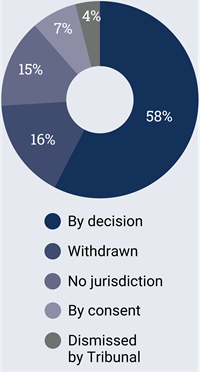 Outcomes of applications for review of decisions, 2019–20b
Outcomes of applications for review of decisions, 2019–20b
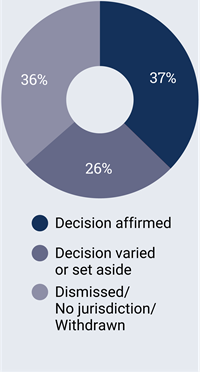
a ‘By decision’ includes applications finalised by a decision of the AAT on the merits under section 43 of the Administrative Appeals Tribunal Act or section 349 or 415 of the Migration Act. ‘No jurisdiction’ includes applications in relation to which the AAT cannot review the decision ‘By consent’ are applications finalised in accordance with terms of agreement reached by the parties.
b Percentages may not total 100% due to rounding
Number of alternative dispute resolution processes, directions hearings and hearings, 2019–20
|
DIVISION
|
CONFERENCESa
|
CONCILIATIONSa
|
OTHER ADR PROCESSESab
|
DIRECTIONS HEARINGSc
|
INTERLOCUTORY HEARINGSd
|
HEARINGS
|
| Freedom of Information |
24 |
0 |
0 |
33 |
8 |
6 |
| General |
6,954 |
427 |
4 |
1,766 |
737 |
1,176 |
| Migration and Refugee |
|
|
|
|
|
11,000 |
| National Disability Insurance Scheme |
2,050 |
93 |
0 |
267 |
79 |
17 |
| Security |
2 |
0 |
0 |
11 |
0 |
2 |
| Small Business Taxation |
130 |
13 |
0 |
66 |
4 |
5 |
| Social Services and Child Support |
|
|
|
490 |
|
11,231 |
| Taxation and Commercial |
261 |
96 |
8 |
633 |
102 |
73 |
| Veterans’ Appeals |
426 |
23 |
1 |
159 |
27 |
49 |
| TOTAL |
9,847 |
652 |
13 |
3,425 |
957 |
23,559 |
a The AAT holds alternative dispute resolution processes in all divisions other than the Migration and Refugee, and Social Services and Child Support Divisions.
b The other ADR processes are case appraisal, mediation and neutral evaluation.
c The AAT holds directions hearings in all divisions other than the Migration and Refugee Division.
d Interlocutory hearings are hearings listed in all divisions other than the Migration and Refugee Division and Social Services and Child Support Division in relation to the AAT’s jurisdiction and applications for orders of the following kind: to extend the time to lodge an application for a review, to be joined as a party to a proceeding, to make a confidentiality order, to stay the operation or implementation of a decision under review, to dismiss an application or to reinstate an application.
In 2019–20, the IAA received 1,745 cases, a 13% increase compared to the previous year, and finalised 1,731 cases. In most cases, the IAA reviews decisions on the papers. 6% of all cases finalised in the reporting period were remitted for reconsideration. By the end of 2019–20 the IAA had achieved a clearance rate of 99%. There were 106 cases remaining on hand as at 30 June 2020. During the reporting period, the IAA also significantly reduced the median number of weeks from referral to decision from 12 weeks in 2018–19 to 5 weeks in 2019-20.
IAA caseload overview
| |
Referrals |
Finalisations |
On hand at year end |
Median time to finalise (weeks) |
| 2018–19 |
1,538 |
2,382 |
92 |
12 |
| 2019–20 |
1,745 |
1,731 |
106 |
5 |
The top 5 countries of reference of referred applicants in 2019–20 were Sri Lanka, Iran, Pakistan, Bangladesh and Iraq. While Sri Lanka remained the largest single source country for referral overall, the number of referrals relating to nationals of Pakistan and Bangladesh increased significantly in the reporting period.
IAA referrals by country of reference, 2019–20
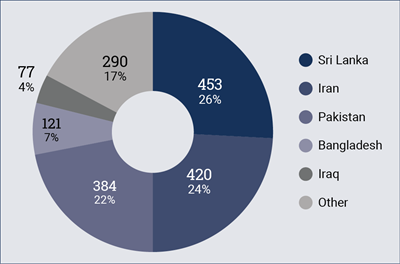
Our performance
Number of finalisations
The number of cases finalised is an indicator of the scale of activity undertaken by the AAT and IAA in carrying out our role of reviewing decisions that affect the interests of individual and organisations. In 2019–20, we finalised a substantial number of applications and referrals, exceeding the annual target for the first time since 1 July 2015 by 9%.

Timeliness
In 2019–20, we fell short of our overall target of finalising 75% of cases within 12 months of lodgement for a second consecutive year. While we met the benchmark in the AAT’s General, NDIS, Small Business Taxation, and Social Services and Child Support Divisions as well as in the IAA, timeliness declined further in the Migration and Refugee Division which accounted for more than half of the AAT’s finalisations in the reporting period. The volume of applications in that Division increased significantly over recent years without a corresponding increase in the number of members and staff to deal with the larger workload contributing to more than 70% of cases finalised in 2019–20 being more than 12 months old.

Publication of decisions
We publish statements of reasons for decisions we make in accordance with our Publication of Decisions Policy to promote public trust and confidence in our decision-making. We well exceeded our 2019–20 target to publish at least 5,000 decisions, breaking last year’s record of publishing the largest ever number of decisions. Our decisions can be found on the Australasian Legal Information Institute website (www.austlii.edu.au).

User experience rating
We seek feedback from parties and representatives about the quality of our services by conducting an online survey administered by an independent organisation. We ask our users for their views on a range of matters, including the process of applying for a review, our information products, dealings with staff, conferences and hearings as well as perceptions of the process overall. The result for the survey conducted in 2019–20 exceeded our target of a rating of at least 70%. Overall, both parties and representatives continued to rate our services positively.

Judicial review outcomes
We aim to have fewer than 5% of all appealable decisions overturned by the courts and the number of appeals allowed by the courts in 2019–20 amounted to 4.4% of all decisions made by the AAT in 2018–19. While we met the performance measure, the result was 2.1 percentage points higher than the previous reporting year which can be attributed to 2 main factors. A large proportion of appeals allowed this year flowed from 2 Federal Court decisions which held that applicants in the Migration and Refugee Division were not properly notified of the original departmental decision, a matter beyond the control of the AAT. The figures also took into account for the first time the outcomes of appeals against decisions of the IAA, a caseload with very high appeal rates, affected by rapidly changing case law and with a large number of appeals not yet finalised.
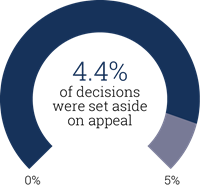
More detailed information about the AAT and our operations can be found in our 2019–20 Annual Report, available on our website (www.aat.gov.au) and on the Australian Government Transparency Portal (www.transparency.gov.au).
 www.aat.gov.au
www.aat.gov.au
 twitter.com/aat_gov_au
twitter.com/aat_gov_au
 youtube.com/AdministrativeAppealsTribunal
youtube.com/AdministrativeAppealsTribunal